Successful project delivery is dependent in large part on your ability to perform quality assurance and quality control, or QA/QC. This is often defined by owners and other stakeholders in the initial scope of work.
But if you can’t check the quality of the work as the project proceeds, you’re much more likely to experience clashes, delays, costly rework, and profit losses. You’re also less able to guarantee the structural integrity of the project, which increases the risk of injury or even loss of life.
When teams implement QA/QC into their workflows, they need the right tools to ensure those definitions and expectations are met. Some of the latest field technology tools are proving to be invaluable in measuring and ensuring quality standards, and detecting when work strays from expected results.
Here’s a closer look at how tools like robotic total stations, 3D laser scanning, and mixed reality can help your teams perform better QA/QC.
1. Detect clashes easier and earlier with a robotic total station
A robotic total station brings greater speed and accuracy to the layout process. But it can also be used for QA/QC purposes by helping you detect clashes between systems and components during the layout process. By bringing BIM models to the field, you can verify that the model accurately aligns to the site and any existing structures before construction begins.
You can also use a robotic total station to proactively survey the components of the structure or building to ensure components are within tolerance guidelines. Should any questions or concerns arise, the tool’s camera and tablet controller can be used to take photos and notes, then share the information back with teams in the office. This documentation can also be used to resolve potential disputes.
The ability to identify potential clashes and discrepancies up front helps your teams solve problems faster and coordinate workflows more effectively. When your teams are working together to identify problems earlier in the process, you can minimize rework, RFIs, and change orders—which saves significant time and money on the project.
2. Benefit from accurate site data with a 3D laser scanner
An intuitive and self-calibrating 3D laser scanner with in-field registration, like the Trimble X7 using FieldLink software, gives your teams the ability to quickly and accurately collect scan data to produce an accurate 3D point cloud representation of a project. This 3D data can be used for QA/QC to design and plan system installation to ensure prefabricated components will fit as expected.
Once construction begins, the 3D laser scanner can be used as the project progresses to validate work and identify potential clashes between the model and the actual environment. Your 3D scans can be shared and used collaboratively to perform design validation inspections remotely.
When you have the ability to quickly gather accurate project information, you can catch clashes or errors earlier and solve them in a virtual model before they turn into much bigger—and costlier—problems down the road.
3. Take QA/QC to the next level with augmented reality
An augmented reality solution, like the Trimble SiteVision, lets you take 3D data to the next level.
By overlaying the project model onto the site, the SiteVision solution improves the QA/QC process by giving your teams the ability to visualize and interact with the model in its real-world environment. This visualization capability makes it easier to detect clashes and identify problems with construction or installation. When teams can actually see how different systems and components interact with each other, they can identify potential problems earlier and make decisions faster.
When teams can interact with the same 3D data in the same environment, communication and collaboration naturally improve. Each team can clearly see how their work fits into context and interacts with other systems, helping them close communication gaps and avoid the QA/QC issues that hurt schedules and budgets.
Perform better QA/QC with Trimble Building Construction Field Systems solutions
The latest field technology solutions streamline workflows, improve coordination, and increase the accuracy of project information—all which help you perform better QA/QC.
Tools like robotic total stations, 3D laser scanners, and augmented reality devices help you:
- Detect clashes and other potential issues early on
- Solve problems quickly to minimize costly rework, RFIs, and change orders
- Communicate and coordinate more effectively
- Make better decisions during each project phase











![[On Demand] Cloud Engine, a point cloud software that has benefits across construction lifecycle](https://play.vidyard.com/krDXXSZc79pBq8qPSi6W2L.jpg)
![[On-Demand Webinar] - Scan Essentials by Trimble, modéliser à partir d'un nuage de points](https://content.cdntwrk.com/mediaproxy?url=https%3A%2F%2Fplay.vidyard.com%2FA8gbz15oHds6JLskjgic5C.jpg&size=1&version=1692731292&sig=26f2e76e220448d9bb5042f0e684237c&default=hubs%2Ftilebg-videos.jpg)
![[On demand webinar] Laser Scanning Myths Busted for Mechanical & Electrical Professionals](https://content.cdntwrk.com/mediaproxy?url=https%3A%2F%2Fplay.vidyard.com%2FEbAQRaubYhCRh1H5qdMoYZ.jpg&size=1&version=1692731300&sig=67ee3bbda98878ba84acb3d96b1ce197&default=hubs%2Ftilebg-videos.jpg)









